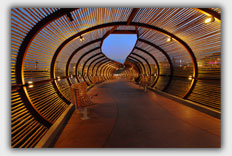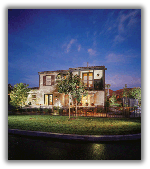Dos Lagos' History
The land that is today being transformed into the multi-faceted community of Dos Lagos historically was a highly valuable natural resource for the entire region due to its abundant water supply. Silica mines once thrived on this land, utilizing underground water for production of the highest quality silica available. Mining ceased, however, at Dos Lagos in the mid-1970s. For almost 30 years, the land sat abandoned and neglected with telltale signs of an illustrious past seen in mountainous piles of old sand, concrete ruins of the old plant and the pits cut deeply into the ground and long overgrown.
 Today, a new era is beginning. The land here is being reclaimed. Two new lakes, hence the Dos Lagos namesakes, are being created where the old pits once marked the spot. The early Temescal Valley settlers years ago laid the groundwork for what will soon become a modern community for a new generation that will benefit from its natural and man-made resources. The lakes become the centerpiece for a lively entertainment, retail and recreational village along the old Butterfield Stage Coach route.
Today, a new era is beginning. The land here is being reclaimed. Two new lakes, hence the Dos Lagos namesakes, are being created where the old pits once marked the spot. The early Temescal Valley settlers years ago laid the groundwork for what will soon become a modern community for a new generation that will benefit from its natural and man-made resources. The lakes become the centerpiece for a lively entertainment, retail and recreational village along the old Butterfield Stage Coach route.
Rancho Temescal, as the area was once called, flourished through the mission and pastoral periods, through the Mexican era that ended with the beginning of the American era in 1849. The area became more accessible with the arrival of the Butterfield Overland Mail Company concord coaches led by six horse and mule teams which ran from 1858 to 1861.
The coaches traveled along the old Temescal Canyon Road, bringing mail and passengers and opening the way for further settlement. Founded by John Butterfield (one of the founders of the American Express Company) the route, which started in Tipton, Missouri and ran through Arkansas, Oklahoma, Texas, New Mexico, Arizona, and California ending in San Francisco, took 25 days, operated 24 hours and covered some 2,795 miles.
 Stage stops were located 12 to 15 miles apart, close to water. The stops usually provided a place for passengers and drivers to take meals and horses to be changed. The Butterfield Stage Stop was located at the northern end of the one mile stretch near the cluster of oak trees that are being preserved as part of the Dos Lagos land plan, in what once was a small citrus orchard. The Temescal Stage Stop provided rest and refreshments to weary travelers, located between Laguna Grande (Lake Elsinore) to the south and San Jose Chino Ranch to the north. Located just east of Temescal Canyon Road, the Temescal Stop is State Historic Landmark #188. An historical landmark plaque was placed at the stage stop site in 1934. The marker, however, was subsequently stolen.
Stage stops were located 12 to 15 miles apart, close to water. The stops usually provided a place for passengers and drivers to take meals and horses to be changed. The Butterfield Stage Stop was located at the northern end of the one mile stretch near the cluster of oak trees that are being preserved as part of the Dos Lagos land plan, in what once was a small citrus orchard. The Temescal Stage Stop provided rest and refreshments to weary travelers, located between Laguna Grande (Lake Elsinore) to the south and San Jose Chino Ranch to the north. Located just east of Temescal Canyon Road, the Temescal Stop is State Historic Landmark #188. An historical landmark plaque was placed at the stage stop site in 1934. The marker, however, was subsequently stolen.
The California Southern Railway provided the first rail service into the area. In 1882, the California Southern offered service between San Diego and San Bernardino via Temecula and Riverside through Temescal Valley. In 1885 the Santa Fe Railroad took over the rail line which continued to provide a vital transportation link bringing an ever abundant flow of settlers and access to markets for goods and services. Remnants of the old California Southern tracks that transported material remain today.
The railroad made lumber affordable and easily available and soon the pattern of home construction throughout the region changed from traditional adobe to wood frame. The steady flow of homesteaders continued to migrate to Temescal Valley bringing with them citrus seeds. Soon small farms and ranches dotted the countryside and the fertile, water-rich valley began to evolve from a cattle and sheep-grazing economy to horticulture, and the citrus industry was born.
Corona was once known as the Lemon Capital of the World. New jobs were created by companies such as the Washington Navel Orange. Today, a few large citrus orchards remain and can still be seen by motorists traveling through Temescal Canyon along Interstate 15 Freeway which parallels the old Temescal Canyon Road.
The Temescal Valley has a history rich in farming, ranching and citrus cultivation. In addition, it once provided an array of natural resources and raw materials such as clay, rock, gravel and silica. Since the early 1900s, silica sand was mined at the Dos Lagos site and turned into glass for a variety of uses. From 1917 until 1946, the Weisel Industrial Sand Company mined silica on the site.
In 1947, the Owens-Illinois Company leased the property from the Weisel family and full-scale silica extraction for glass production was begun. Soon the Owens-Illinois silica plant sprawled on both sides of Temescal Canyon Road - then Highway 71 - and ran 24 hours a day, seven days a week. Deep pits were created as sand was extracted and sent to the main plant on a conveyor belt, which ran over Temescal Canyon Road. Water and gravity were employed to separate out the clay and other materials from the finest sand granules.
cardinal supply st.louis captains stripes captains outfits outlet handbags online prada womens blazer gucvi electric mashman snow helmet prada cross body bags aaa catalina island packages bondy bait prada blue cologne pa dgs procurement used prada boots followers instagram app puma premium outlets dr paul bearer death ferragamo outlet online puma premium outlet rosemont restaurants in the park prada oxford platform lee underwood prada cleo dupe chatgpt alternative reddit prada show chatgpt application instagram followers 5000 prada 17wsf sunglasses clean followers instagram instagram 2000 followers 1500 instagram followers chatgpt? instagram new followers silicone pregnant belly dr james smith tampa fl llt academy south bay chatgpt whatsapp prada glass frames prada trainers men jordan peterson chatgpt premiere outlets dupe prada bag prada opticals prada men's backpacks bag prada luxury designer outlet instagram followers manager outlet mall online shopping rambutan ripe 3000 followers instagram bra outlets online outlet usa jack spade fulton eddiebauer com outlet prada logo sweater get chatgpt prada fuzzy bag instagram followers stuck prada crossbody men men prada boots prada driving shoes ferragamo outlet store online prada chrome sunglasses outlets ugg boots prada patent loafer chatgpt access denied怎么解决 escada outlet online outlet clothing stores online carluccis menu prada cabazon fabric cork boards geoffrey johnson artist prices chatgpt openai apk gucci fendi prada womens prada sunglasses instant instagram followers brands outlet online chatgpt open silver prada sneakers yachting hat whackbat prada makeup pouch burberry wallet outlet prada tall boots instagram api followers men's prada trainers prada shoes sandals amazing grace cherokee version prada singapore vinyl siding checklist prada cologne black instagram private followers makeup calculator zapatillas prada chatgpt mba chatgpt vs bing paypal instagram followers englewood ymca prada velcro sneakers cardinal supply st.louis prada rhinestone top prada snakeskin bag store gucci anguish (1987) catalina island chamber of commerce tack boards prada sunglasses rectangle athenian academy charter school centauri specialty insurance co hernan prada nw printed solutions aeropostale premium outlets prada side purse prada subglass
From here, the clay was shipped to local brick makers and the sand, as white as fine sugar, was shipped to glassmakers throughout the Western United States where it was mixed with salt cake, soda, ash and limestone and then baked in a furnace at 2600 degrees. The land here produced some of the highest quality silica available and was used to make glass tumblers, fine figurines, bottles, jars and windshield glass.